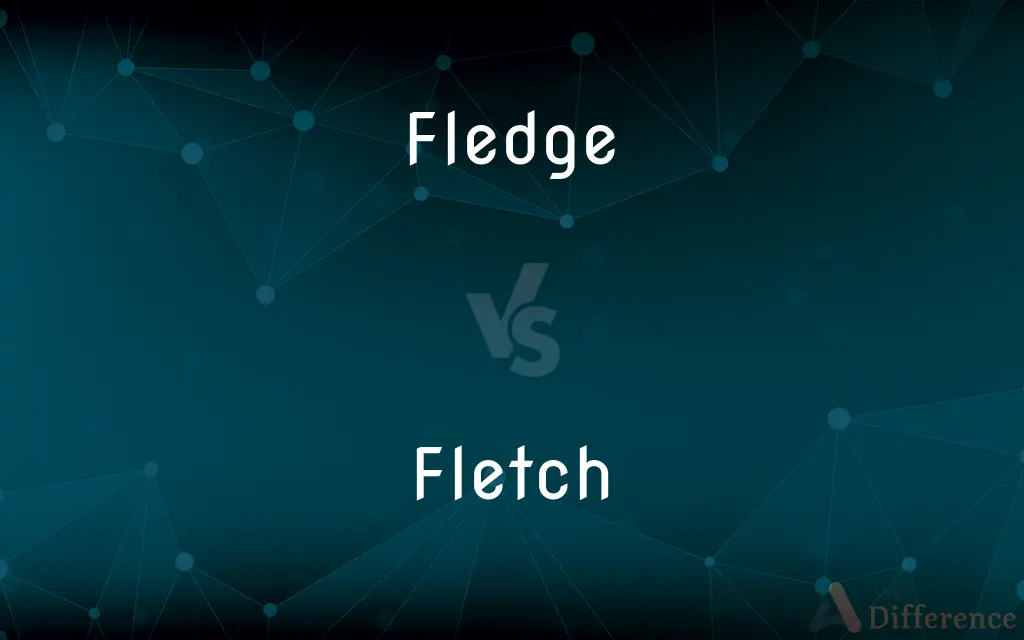Fledge vs. Fletch — What's the Difference?
By Tayyaba Rehman & Maham Liaqat — Updated on April 6, 2024
Fledging is the process of a young bird growing feathers for flight, while fletching involves attaching feathers to an arrow for stability.

Difference Between Fledge and Fletch
Table of Contents
ADVERTISEMENT
Key Differences
Fledge refers to a young bird's development stage when it grows feathers necessary for flight. This is a critical phase in a bird's life, signifying its growing independence and readiness to leave the nest. Fletching, on the other hand, is a term used in archery to describe the process of attaching feathers or vanes to the shaft of an arrow. These feathers are crucial for the arrow's flight stability, ensuring it travels towards its target accurately.
While fledging is a natural, biological process that occurs as part of a bird's growth and development, fletching is a human craft, practiced for centuries to improve the performance of arrows in hunting and archery. The former is a milestone in the lifecycle of birds, marking their transition towards adulthood and self-sufficiency. In contrast, fletching is an essential skill in archery that requires precision and understanding of aerodynamics.
Fledging is observed in the wild and in captive breeding programs, where the growth of feathers is monitored as a sign of health and developmental progress. Fletching, however, is performed by archers and craftsmen who specialize in making and repairing archery equipment. This distinction highlights the difference between a natural process and a human skill.
In the context of their respective fields, fledging is a term primarily used by ornithologists, bird watchers, and conservationists interested in avian biology and ecology. Fletching is used by archers, historians, and enthusiasts of traditional crafts, underscoring its relevance in sports and historical weaponry.
Comparison Chart
Definition
The process of a bird growing flight feathers
The process of attaching feathers to an arrow shaft
ADVERTISEMENT
Context
Ornithology, bird development
Archery, craftsmanship
Purpose
Signifies readiness for flight and independence
Improves arrow stability and accuracy
Skill vs. Natural Process
Natural developmental stage
Human crafting skill
Field of Relevance
Biology, ecology
Sports, history of weaponry
Compare with Definitions
Fledge
Indicator of Health.
The chick's ability to fledge showed it was well-nourished.
Fletch
Archery Skill.
He learned to fletch arrows to improve his archery accuracy.
Fledge
Sign of Maturity.
As the young bird's feathers began to fledge, it became more active.
Fletch
Sport and Hunting.
Modern archers still practice fletching to customize their equipment.
Fledge
Natural Process.
Fledging is a crucial phase in a bird's life cycle.
Fletch
Historical Relevance.
Fletch has been a vital skill since ancient times for hunters and warriors.
Fledge
Preparation for Independence.
Fledging allows young birds to venture from their nests confidently.
Fletch
Craftsmanship.
Fletching requires precise alignment of feathers on the arrow.
Fledge
Developmental Stage.
The eagle began to fledge, indicating it would soon leave the nest.
Fletch
Aerodynamics.
Proper fletching can significantly affect an arrow's flight path.
Fledge
Fledging is the stage in a flying animal's life between hatching or birth and becoming capable of flight. This term is most frequently applied to birds, but is also used for bats.
Fletch
To feather (an arrow).
Fledge
(of a young bird) develop wing feathers that are large enough for flight
The young fledge around four weeks after hatching
Fletch
(archery) The vane toward the back of an arrow, used to stabilise the arrow during flight.
Fledge
To raise (a young bird) until it is ready to leave the nest
A pair of ducks that fledged several young.
Fletch
(fisheries) A large boneless fillet of halibut, swordfish or tuna.
Fledge
To cover with or as if with feathers.
Fletch
(transitive) To feather, as an arrow.
Fledge
(Archaic) To provide (an arrow) with feathers.
Fletch
To feather, as an arrow.
[Congress] fletched their complaint, by adding: "America loved his brother."
Fledge
To grow the plumage necessary for flight.
Fledge
To leave the nest
Nestlings that are about to fledge.
Fledge
(transitive) To care for a young bird until it is capable of flight.
Fledge
(intransitive) To grow, cover or be covered with feathers.
Fledge
(transitive) To decorate with feathers.
Fledge
(intransitive) To complete the last moult and become a winged adult insect.
Fledge
(archaic) Feathered; furnished with feathers or wings; able to fly.
Fledge
Feathered; furnished with feathers or wings; able to fly.
His shoulders, fledge with wings.
Fledge
To furnish with feathers; to supply with the feathers necessary for flight.
The birds were not as yet fledged enough to shift for themselves.
Fledge
To furnish or adorn with any soft covering.
Your master, whose chin is not yet fledged.
Fledge
Feed, care for, and rear young birds for flight
Fledge
Decorate with feathers;
Fledge an arrow
Fledge
Grow feathers;
The young sparrows are fledging already
Common Curiosities
Why is fletching important in archery?
Fletching is crucial for stabilizing the arrow's flight, enhancing accuracy and performance.
Can all birds fledge?
All bird species go through a fledging process, though the timing and nature of feather development vary.
What is fledging?
Fledging is the stage in a bird's life when it grows feathers that are essential for flight.
What materials are used for fletching arrows?
Traditionally, feathers are used for fletching, but modern arrows may also use plastic vanes.
How does fledging indicate a bird's health?
Successful fledging, where a bird develops strong, healthy feathers, indicates good nutrition and overall health.
How do ornithologists study fledging?
Ornithologists observe and document the development of feathers in young birds to study their growth and behavior.
Are there any modern alternatives to feather fletching?
Yes, modern arrows often use plastic vanes as a durable and consistent alternative to feathers.
Does the type of feather affect the fletching process?
Yes, the type and quality of feathers can influence the arrow's flight characteristics.
What role does fledging play in conservation efforts?
Monitoring fledging rates can help assess the health and viability of bird populations in conservation projects.
Can fletching be done with machine precision today?
Modern technology allows for precise fletching, though hand-crafted fletching is still practiced for custom arrows.
What is the historical significance of fletching?
Fletching has been essential for hunting and warfare, dating back to ancient civilizations.
Do all arrows need to be fletched?
Yes, for an arrow to fly accurately and efficiently, it must be properly fletched.
Is fletching an easy skill to learn?
Fletching requires precision and understanding of aerodynamics, making it a skill that improves with practice.
Can fledging be observed in all environments?
Yes, fledging occurs in various environments, from dense forests to urban areas, wherever birds are found.
How long does the fledging process take?
The duration of fledging varies among species, ranging from a few weeks to several months.
Share Your Discovery

Previous Comparison
Sorceress vs. Witch
Next Comparison
Pregraduate vs. UndergraduateAuthor Spotlight
Written by
Tayyaba RehmanTayyaba Rehman is a distinguished writer, currently serving as a primary contributor to askdifference.com. As a researcher in semantics and etymology, Tayyaba's passion for the complexity of languages and their distinctions has found a perfect home on the platform. Tayyaba delves into the intricacies of language, distinguishing between commonly confused words and phrases, thereby providing clarity for readers worldwide.
Co-written by
Maham Liaqat











































